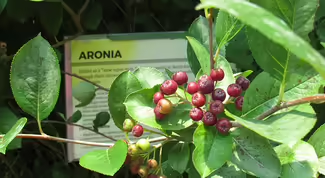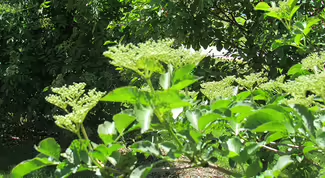
Enhance Your Garden with Edible Landscaping Shrubs
The integration of edible landscaping shrubs into Bloomington-Normal area gardens, sidewalk strips, fence lines, and elsewhere can add beauty, ecological function, and food security to our area. Four standout shrubs should be considered for planting this season: American elderberry (Sambucus canadensis), serviceberry (Amelanchier species), aronia (Aronia melanocarpa), and black currant (Ribes nigrum). These shrubs have many benefits to share with their growers.
American Elderberry (Sambucus canadensis)
American elderberry, once established, can produce huge clusters of flowers – even in its second year of growth. The flowers look great, add a sweet smell to garden air, and can even be used to make an Eastern European late spring delicacy called socata – a kombucha-like, sparkling beverage which uses elderflowers. Elderflowers attract pollinators en masse and can specifically serve as a host plant for many species of butterfly larvae. Thriving in moist, well-drained soils, American elderberry prefers full sunlight but can growth in partial shade very easily. Elderberry requires minimal care once established, since it is native to our area of North America. In Central Illinois, we expect to harvest its dark purple berries in mid-to-late July, depending on weather. Be sure to plant this plant where it is OK if the shrub spreads out in future years.
Serviceberry (Amelanchier species)
Serviceberries (also known as Juneberries, Saskatoons, and other names) take the form of medium-sized shrubs or small trees (depending on cultivar selected at gardening centers) and are showstoppers in springtime. They produce many small white flowers in May that are soon buzzing with bees and other pollinators. Serviceberry can thrive in various soil types and light conditions, making them adaptable to diverse garden landscapes. Before summer officially begins in early June, its berries transition from green to red and finally to blue or deep purple, signaling their readiness for harvest.
Aronia (Aronia melanocarpa)
Aronia, also known as chokeberry, puts on tall clusters of white flowers in spring, followed by glossy, dark black berries in late summer to early fall. Beyond its aesthetic appeal, aronia's berries pack a nutritional punch, rich in antioxidants and vitamins. Aronia does well in moist, slightly acidic soils and partial shade, but can grow well in various environments. In Illinois, berries are ready for harvest when they turn dark purple or black. Their skins are extremely tannic, so many enjoy pressing them for their juice and cutting them with apple juice, or else adding them to smoothies to diluting their tannic yet nutritious bite.
Black Currant (Ribes nigrum)
Black currant produces small, interesting flowers in spring that can range in color from pale yellow to green to pale red. These flowers attract bees and other beneficial insects known to attack garden insect pests. Black currants perform best in fertile, well-drained soils and full sun to partial shade, but are up to 50% shade tolerant. This characteristic makes them ideal additions to most any place they are planted. Black currant bushes benefit from regular watering and mulching to retain soil moisture. In Illinois, anticipate harvesting the tart, versatile-flavored black berries around the second week of July, give or take a week, depending on weather and cultivar.
With the manifold benefits that these plants can provide, there are some basic shrub care requirements to follow to make sure they grow and produce well. Pruning is a large part of this. All these woody perennials need pruning annually, between mid-January to early March. Pruning promotes vigorous, healthy growth, along with good flower and fruit production by removing dead, diseased, dying, or damaged wood while increasing airflow and light penetration. Regular watering during drought and annual organic fertilizer applications in spring are all that's required to ensure long-term plant health of all four species.
Contact your local Extension personnel for questions regarding pruning, fertility, or best management practices of edible perennial shrubs. Look to local garden center companies to source these amazing species.
ABOUT EXTENSION: Illinois Extension leads public outreach for University of Illinois by translating research into action plans that allow Illinois families, businesses, and community leaders to solve problems, make informed decisions, and adapt to changes and opportunities.
###
COLLEGE OF AGRICULTURAL, CONSUMER & ENVIRONMENTAL SCIENCES
University of Illinois | U.S. Department of Agriculture | Local Extension Councils Cooperating
University of Illinois Extension provides equal opportunities in programs and employment.
If you need a reasonable accommodation to participate in this program, please contact us.
Early requests are strongly encouraged to allow sufficient time for meeting your access needs.

